Museums and Exhibitions in New York City and Vicinity
| Home | | Museum Guide | | International | | Architecture & Design | | Theater |
GLENN LONEY'S MUSEUM NOTES
CONTENTS, June 2004
Please click on "
* " to skip to each subject in this index:
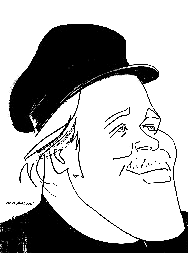
|
|
| Caricature of Glenn Loney by Sam Norkin. | |
Listing Between Planes— *
A Quick Tour of San Francisco Museums: *
At the California Palace of the Legion of Honor: *
Art Deco 1910-1939 Features Strand Palace
Hotel Foyer! *
Also at the Palace of the Legion of Honor: *
Photo Images in American Prints, 1960s-1990s— *
Pipilotti Rist's New Video: *
Stir Heart, Rinse Heart— *
At SF Museum of Modern Art: *
Larry Sultan: The Valley—Between Porn-Film
Shoots! *
POP! From San Francisco Collections— *
IN PROCESS: *
San Francisco's New de Young Museum— *
Orienting Viewers in the SF Asian Art Museum— *
From Manhattan's Frick to Pittsburgh's Clayton— *
At the Pittsburgh Frick Art Museum: *
AUGUSTUS SAINT-GAUDENS: *
American Sculptor of the Gilded Age— *
At the Whitney in Manhattan: *
Cotton Puffs, Q-Tips©, Smoke & Mirrors; The Drawings of Ed Ruscha— *
Ed Ruscha and Photograpy— *
Ana Mendieta: Earth Body *
At the BARD Center: *
VASEMANIA: NeoClassical Form & Ornament— *
At the Dahesh Mueum: *
FROM HOMER TO THE HAREM: *
The Art of Jean Lecomte du Nouÿ— *
At the New-York Historical Society: *
IF ELECTED: Campaigning for the Presidency— *
At the Lincoln Center Library for the Performing Arts: *
Margot Fonteyn in America: A Celebration— *
…to illuminate the scene: *
Ellen Terry, Edith Craig, Edward Gordon Craig, and John Gielgud— *
Archives of Two Broadway Musical Teams Come to Lincoln Center: *
Hal Prince Salutes Bock & Harnick and Kander & Ebb in Tribute! *
At the Metropolitan Museum of Art: *
CHILDE HASSAM: American Impressionist— *
RUHLMANN:
Genius of Art Deco— *
NEW YORK MUSEUM NOTES—
CURATORS’ CHOICE 2004.05
By Glenn Loney
July 2004
©Glenn Loney, 2004
Although some very interesting—even important—art exhibitions have opened recently, your reporter can do little more than list them. He has just returned from the Oregon Shakespeare Festival in Ashland, plus a day of photographing Portland Landmarks for the ©INFOTOGRAPHY ArtsArchive.
In a few hours, your scribe will be on another airplane: this time to Munich and the annual Opera Festival. Followed by the Festivals of Bayreuth, Bregenz, Salzburg, & Edinburgh.
The week prior to Oregon, he was in Pittsburgh for its First National Performing Arts Conference and the annual confab of the Music Critics of North America. The week before that, he was in San Francisco for the annual conference of the American Theatre Critics Association.
Even while functioning as a Performing Arts critic/journalist, however, your reporter took time to check out some museums outside New York.
A Quick Tour of San Francisco Museums:
The purpose of my trip to San Francisco was to join colleagues of the American Theatre Critics Association, checking out new plays and production-standards of Bay Area Theatres. But SF has so many museums, galleries, and landmarks that they also demanded a visit, however brief.
At the California Palace of the Legion of Honor:
Thanks to arts-patron Alma de Brettville Spreckels—and the Spreckels Sugar Fortune—San Francisco has its very own copy of Paris' original Palace of the Legion of Honor. It sits on a promontory in Lincoln Park, overlooking the Golden Gate.
Currently, it is sharing its permanent exhibition space with collections from the old M. H. De Young Museum, which has been demolished to permit construction of a new De Young on the same Golden Gate Park site.
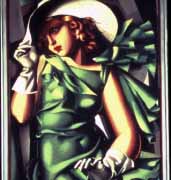 |
| GIRL IN A GREEN DRESS--Tamara de Lempicka's Art Deco portrait on view in San Francisco. |
Art Deco 1910-1939 Features Strand Palace Hotel Foyer!
[Closing July 4, 2004]
[Re-opening: Museum of Fine Arts Boston, September 10, 2004]
Even more of the De Young and the Legion's permanent collections had to be dislodged to permit the installation of this amazing survey of Art Deco.
The centerpiece is the gleaming chrome & glass foyer-entry of London's Strand Palace Hotel. It is a glorious almost-altar-like entrance. Sad that it was removed from the actual hotel, which today is only a tacky reminder of what it once had been.
At least it was preserved by the Victoria & Albert Museum, which has important Deco arts & artifacts. And which organized this dazzling show. Many of the signature-objects on view your scribe had previously photographed at the V & A and elsewhere for THE ART DECO NEWS & THE MODERNIST.
Tamara de Lempicka's stunning portrait—Jeune fille en vert—is the Poster-Girl for this touring exhibition. It's the essence of Parisian Deco, but de Lempicka called her distinctive style Synthetic Cubism!
Over 300 objects & artworks are included, from collections worldwide, though many of the most important artifacts were created in France, Britain, and the United States. Not only artworks are on view, however. Sleekly streamlined household appliances and even a marvelous white Cord convertible are on display.
Designer-inspirations are traced to such sources as the Maya, Ancient Egypt, Africa, and the Orient. If you don't get to see this show in Boston, do get the handsome catalogue to see what you missed.
Also at the Palace of the Legion of Honor:
Photo Images in American Prints, 1960s-1990s—
[Closing July 18, 2004]
[Closing September 12, 2004]
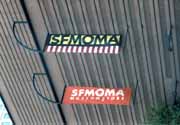 |
|
SF MOMA EXTERIOR--Substituted to protect readers from Larry Sultan's photos of Porn-Film Interiors! Photo by: ©Glenn Loney/INFOTOGRAPHY, 2004. |
Larry Sultan: The Valley—Between Porn-Film Shoots!
[Closing August 1, 2004]
If you are looking for smut, you won't find it in Larry Sultan's large-scale color-photographs of San Fernando Valley homes being used as sets for Porn Films. You may see some naked performers breaking for a smoke. Or getting their act together.
But the subliminal thrust of the images is that these often luxurious interiors and gardens are ordinarily the homes of fairly prosperous people. Possibly Wealthy Republicans—but renting out their living-rooms for Porn Shoots does seem out of keeping with the Great Moral Force said to reside with them.
Curatorial wall-texts offer ingenious insights into what the images do not show. But which they do suggest, at least to curators…
These are very good, detailed photos. But you might want to rent Debbie Does Dallas instead…
POP! From San Francisco Collections—
[Closing September 19, 2004]
SF MOMA is also showing off some notable Pop! Artworks locally owned. As well as a series of colorful Hippie band-posters from the late 1960s. [Your scribe also has a large collection of these: Jefferson Airplane, Family Dog, Moby Grape, etc.]
California artists such as Robert Arneson, Wayne Thiebaud, and Ed Ruscha—he's also currently at the Whitney—are showcased. Nor are Warhol, Oldenburg, or Lichtenstein overlooked. All the Usual Suspects!
 |
| ARCHITECTS' VISION OF NEW DE YOUNG MUSEUM: San Francisco gets a design from Old Europe. |
San Francisco's New de Young Museum—
Constructed in Spanish Plattoresque style for the 1915 Pan-Pacific Exhibition—though in Golden Gate Park, instead of in the Marina—the Michael H. de Young Museum was a wonder to behold, even as late as 1939 and the Golden Gate International Exhibition on Treasure Island.
Because of danger of falling stucco decorations, the original ornament was eventually stripped off. After the 1989 Loma Prieta Earthquake—which did some real damage, the museum was shored-up with external metal-girders. Finally, it had to be closed in 2000.
Now the beloved old museum-complex has vanished entirely, replaced with a new De Young-In-Progress. Its distinctive feature will be a multi-story tower, rising in a twisting parallelogram. This oddity will be entirely devoted to Arts Education.
The architects are the trendy Swiss firm of Herzog & de Meuron. They have won the Pritzker Prize and a number of prestigious commissions. The three-level copper-clad hulk they have designed already looks like a metal fortress. But at least there will be plenty of wall-space for displaying artworks. You don't need windows where you could hang the museum's El Greco!
Across the Bay, UC/Berkeley has a justly famed School of Architecture. So has Yale, for that matter. What is it with American Museums: that they prefer foreign designers to Native Genius? The boring new MoMA in Manhattan is a Japanese product, no less.
The new De Young Museum will open in the autumn of 2005. There will surely be many surprises in the ingenious ways the architects—consulting with curators—have reconformed exhibition-spaces.
For the Record: Both the De Young and the Legion of Honor comprise the Fine Arts Museums of San Francisco. SF MoMA is an entirely different fiefdom.
The FAM SF administrators like to write the title as de Young, but this computer perfers capitals. Michael H. de Young and his family were the proprietors of the once prestigious San Francisco Chronicle, now owned by the Hearst Interests—whose former SF signature-newspapawer, the Examiner, is sadly now a tabloid throw-away freebie.
Orienting Viewers in the SF Asian Art Museum—
In the SF Civic Center, a noble Beaux Arts building—which was once the Public Library—is now the ASIAN ART MUSEUM. Its extensive collections had long ago outgrown the wing it once occupied at the doomed De Young Museum. Avery Brundage—of Olympic Committee Fame—had formed the priceless core-collection.
This spacious three-level showcase devotes special areas to the arts & histories of South Asia, Southeast Asia, Japan, Korea, and China, as well as to The Persian World and West Asia and the Himalayas and the Tibetan Buddhist World.
If you love Ganesh—the Elephant-headed god who removes barriers from your pathway—you will find some impressive images among these collections. There's even an Elephant Throne, from the era of the British Raj in India.
Across the plaza from the Asian Museum is the new—and almost matching in outline & volume—San Francisco Public Library. But its lines and decoration are Post Modernist, rather than Beaux Arts.
In fact, it is quite handsome and thoroughly technologically advanced. It's both digital and traditional. There are still books on shelves, and posters on walls!
Books still win out: there are over a million of them. But only 6,000 Compact Disks. The Big Statistic is Goverment Documents: there are almost six-million of them on file!
Also worth a visit is the EXPLORATORIUM, located behind the great Bernard Maybeck Beaux Arts Rotunda of the 1915 World's Fair Palace of Fine Arts. New Yorkers have been able to experience some of its best displays this season at the American Museum of Natural History.
New York has its own Victorian Glass-Palace Conservatory up in the Bronx, in the New York Botanical Garden. But San Franciscans are even more proud of their Golden Gate Park Conservatory.
Opened in 1879, its dome burned in 1883. It was repaired shortly after. And repainted & reglazed in 1946, after World War II. It was nearly ruined by storms in 1995. But now it has been restored to its original beauty.
With the motto: IT'S A JUNGLE IN HERE!, this lovely glass-house is known as the Conservatory of Flowers. And it specializes in Tropical and Aquatic Plants.
From Manhattan's Frick to Pittsburgh's Clayton—
In Pittsburgh for the annual conference of the North American Music Critics, I took some time off from hearing about the death of print-media and editors' lack of interest in cultural matters to see what the once-smokey city had to offer in the way of museums. Of course the Heinz Family had founded a number of cultural repositories, though not quite 57 Varieties.
Andrew Carnegie—in addition to his gift of Public Libraries all over America—had richly gifted Pittsburgh. Just down the street from the imposing Heinz Chapel on the University of Pittsburgh campus, Carnegie's Music Hall, Art Gallery, & Museum of Natural History took me two whole days to explore.
As I live across the street from the Frick Collection in Manhattan, I asked my friend, Heidi Rosenau, of the Communications Office, to open the doors for me at Clayton, Henry Clay Frick's beloved family home in the Pittsburgh suburbs.
Her Pittsburgh counterpart, Greg Langel, was waiting for me in his office above Frick's handsome Carriage-House—now filled with vintage horse-drawn conveyances and automobiles. Greg explained that Frick's daughter, Helen Clay Frick—although she resided in the Fifth Avenue mansion when in New York—actually preferred to live at Clayton.
This is a handsome Victorian mansion—several times enlarged, but still on a fairly intimate family-scale. It has been carefully restored, including the aluminum—instead of silver-leaf—detailing in ceiling-decorations. The furniture is Heavy Victorian, for the most part: Chests of drawers almost altar-like…
Mr. and Mrs. Frick's separate bedrooms—but with a joining corridor—bespeak the Masculine and the Feminine. Even Helen Frick's childhood bedroom remains as it was.
It has been said that all the bad art Frick bought has been exiled to Clayton, while the real Masterpieces are on view in Manhattan. In the home itself, there are certainly some Victorian canvases that would never make it at the Met. Or across the street from me, either. But it's clear that the Frick Family loved these paintings and objects d'art but did not put them on public display in their museums.
In the handsome Frick Art Gallery—also on the estate—Helen Clay Frick showed her favorites, some of which have been on view in New York on occasion. True enough, some of these canvases are "attributed to," rather than certified masterworks.
Greg Langel provided me with an excellent guide to Clayton, the Art Museum, and the other amenities of what's called The Frick Art & Historical Center. It's subtitled: The Art & Life of a Pittsburgh Family.
But not just any family… The estate, after all, is more than five acres, including an impressive Frick Park across from the main complex of buildings.
But then there were also the Mellons, the Heinzes, the Pitcairns—Pittsburgh Plate Glass, and, of course, the Carnegies. All Important Families, all arts patrons and collectors. Some of this history is chronicled in a handsome & hefty volume Langel presented to me from the Frick shelves: Collecting in the Gilded Age: Art Patronage in Pittsburgh, 1890-1910.
Beyond the Gilded Age, patronage continued. The neo-gothic Heinz Chapel is more like a cathedral, but then it's just across the lawn from the Cathedral of Learning of the University of Pittsburgh. This awesome Deco/Gothic skyscraper has a cavernous three-story central internal court which could dwarf many a European cathedral.
Around this core—on the first and third floors—are suites of the strangest college classrooms in the world. Each one is decorated and furnished in the style of a different nation!
Try taking notes in the classroom consecrated to Poland! Austria's room suggests Rosenkavalier elegance, but it is undergoing repairs at the moment.
Even though the trip from downtown out to Clayton by muni-bus takes a while, it's well worth the journey. And, if you are a Senior, in Pittsburgh, YOU RIDE LOCAL TRANSIT FREE!
Speaking of Andrew Carnegie: His Pittsburgh and American benefactions are well-known. But few realize the largesse he showered on his hometown in Scotland.
In New York, the slogan is: THERE'S ONLY ONE CARNEGIE HALL!
This is not true—and I have taken photographs to prove it false! In Dumfermline, near Edinburgh, a handsome neoclassical concert-hall also bears the name: CARNEGIE HALL!
At the Pittsburgh Frick Art Museum:
American Sculptor of the Gilded Age—
[Closing July 3, 2004]
[Re-opening: Georgia Museum of Art, July 29, 2004]
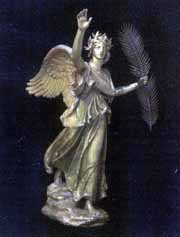 |
| GOLDEN "VICTORY"--Augustus Saint-Gaudens' Herald for his General Sherman Monument on Fifth Avenue at Grand Army Plaza. Photo courtesy of the Frick Art Museum |
In addition to its permanent collections, the Frick Art Museum has been showing a major exploration of the sculptural achievements of Augustus Saint-Gaudens. The various impressive bronze reliefs, plaster casts, models, and statues are largely drawn from Saint-Gaudens' own studios, now the Saint-Gaudens National Historic Site, in Cornish, New Hampshire.
Among the objects on view is a plaster model of the head of Admiral David Farragut, made for the major sculptural installation in Manhattan's Madison Square Park. Also displayed is a version of the sculptor's Diana, originally created as a weather-vane for Stanford White's Madison Squre Garden.
And, of course, there's the golden figure of Victory, also permanently on view in New York, in Grand Army Plaza, leading General Sherman on to victory, from Atlanta to the sea…
Much smaller studies for the famed Lincoln Memorial, in Washington, DC, are shown. As is one of the versions of the relief Saint-Gaudens made of Robert Louis Stevenson. A large casting of this is mounted in St. Giles Cathedral, in Edinburgh.
This show has a tour-circuit of no less than eleven museums. But if you cannot follow it to Boston—and you can come to the Met Museum in New York, you will find Saint-Gaudens' Stevenson, Diana, Amor Caritas, Adams Memorial, and a charming relief of Jacob Schiff's children in the Englehardt Court of the American Wing!
There is also a very handsome catalogue of the exhibition, with the same title as the show itself. And major works are clearly reproduced in color, on a fairly large scale.
It is published by the DC Trust for Museum Exhibitions, which had it printed in Hong Kong. Talk about OUTSOURCING!
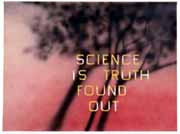 |
|
Science Is Truth
Found Out |
Cotton Puffs, Q-Tips©, Smoke & Mirrors; The Drawings of Ed Ruscha—
[Closing September 26, 2004]
Years ago in Los Angeles, I met Ed Ruscha at a show of his work. I called him ROOshuh, in effect, and he didn't correct me. Now, at the Whitney, he is known as Ed RooshAY. This sounds very elegant, very French. Was he only being polite way back in LA? His catalogue for that show had a cover of two sheets of sandpaper—not what you'd expect from an artist interested in being polite.
Curatorial Cues: Ruscha often uses cotton-puffs and Q-tips to fashion his often photo-like panels, many of which feature Jenny Holzer-like slogans or mottos against softly colored backgrounds.
Among the titles on his panels at the Whitney—rendered variously in sans-serif typefaces or artful calligraphy—are such gems as: Quit, HONK, Lips, Worm, Discontinued China, DIRTY BABY, I'VE BEEN WALKING, TALKING, BELIEVING, MoTor, BABYCAKES, HONEY, I TWISTED THROUGH MORE DAMN TRAFFIC TODAY, and The End—in Gothic letters.
These are not the only gimmicks Ruscha has on show. There are more than 200 drawings, from over four decades of creativity. Ruscha is known—curatorially, at least—for his genius at deadpan and for his "wry juxtapositon of words and objects."
This show fills an entire floor of the Whitney, and it is not without its more amusing moments. But don't plan to spend the whole afternoon trying to figure out Ruscha's Message.
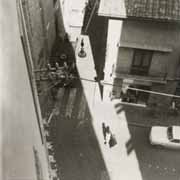 |
| Florence, Italy Edward Ruscha, 1961 Gelatin silver print , 3 1/2 x 3 1/2 in. Whitney Museum of American Art, New York; Gift of the artist; courtesy Gagosian Gallery, T.2002.210.383 © Ed Ruscha Photograph by Sheldan C. Collins |
[Closing September 26, 2004]
If you didn't get enough in the upstairs Overview of Ed Ruscha's drawings, you can savor his talents as a black & white photographer in the Whitney's small ground-floor gallery. This should have special resonance, for he is said to see his drawn images somewhat photographically.
When he took a trip to Europe, Ruscha snapped a lot of photos of variously undistinguished buildings and objects. In America, he also focuses on iconic wastlelands.
The smaller photos are given greater weight by matting and framing them in rather overlarge wooden squares of uniform size & shape. The framing may well be part of the desired effect…
In recent editions of Kassel's Documenta, tiny black & white snapshots have come into their own. But they are usually arranged in long rows—two, three, or four close-set rows—with all the photos very close together, margin-to-margin.
The effect of these long rows against white exhibition walls is often more arresting than the pictorial content of most of the snaps.
So don't throw away your mother's old snapshots of family birthdays. MoMA may be lying in wait to snatch them away from you and mount a major show about the Iconic American Family!
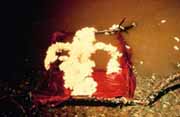 |
| Untitled (Flower
Person) Ana Mendieta, 1975 Lifetime color photograph , 8 x 10 inches (20.3 x 25.4 cm) Collection Melva Bucksbaum and Raymond Learsy © Estate of Ana Mendieta Collection |
[Closing September 19, 2004]
The medium of photography was essential to the late Ana Mendieta, but largely as a way of documenting her images of herself or generalized female bodies in the earth. The way in which she photographed some of these quasi-installations or earth-sculptures gives them even more resonance.
Even early action-paintings have interest both as traces of bloody hands moving down a canvas, as well as photographs—and even videos—of the actual creation of the canvas.
Some works—which may have been intended to celebrate the Eternal Feminine and the Union of Woman with Mother Earth—can, owever, be read in quite a different way. Some suggest a woman bound and entombed in a muddy grave, waiting only for the shovels of soil to be thrust upon her helpless form.
This is a very disturbing exhibition. And what about all that debate about her "untimely death"? Maybe her time was up?
VASEMANIA: NeoClassical Form & Ornament—
[Closing October 17, 2004]
Although all the vases and designs for vases on view at the Bard Grad Center until October are on loan from the Met Museum, do not think you can miss this ornate show and see these often fantastic vessels later at the Metropolitan.
The Met has tons of antiquities and artworks in its basement. No major Met galleries have been plundered to make the Bard's show possible. So this may the the only time you will be able to see some of these elaborate—almost sculptural & monumental—vases.
Among them will be Josiah Wedgewood's copy of the famed Portland Vase. The Sévres Porcelain Manufactory—a great favorite at the Bard—will also be well represented.
The Art of Jean Lecomte du Nouÿ—
[Closing September 19, 2004]
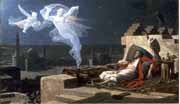 |
| EUNUCH'S DREAM AT THE DAHESH--Erotic Academic Artwork! Photo courtesy of the Dahesh Museum of Art |
At the Dahesh Museum, Academic or Salon Art of the 19th century is always center-stage. But, even as Impressionism, Cubism, and other modern isms were shoving the Academicians into the wings, at least one talented artist continued working in that tradition. He was Jean Lecomte du Nouÿ—and he lived on into 1923
But his most important works—especially those influenced by Orientalisme—are firmly rooted in the 19th century. Nonetheless, in addition to the professional finish he brought to his canvases, Lecomte du Nouÿ always had an "edge," something in his subject or his rendering which disturbed.
The new show at the Dahesh features a hundred of his paintings, drawings, and oil-sketches. The show's title suggests the painter's range of interests, from Classsical Mythology to the Mysteries of the Seraglio. Often, there is an erotic, even mystical, overtone in his treatment of such subjects and narratives.
At the New-York Historical Society:
IF ELECTED: Campaigning for the Presidency—
[Closing November 3, 2004]
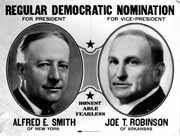 |
| Regular Democratic Nomination. Photo courtesy of the New York Historical Society |
To avoid illegal Electioneering at the Polls, the New-York Historical Society is circumspectly closing this Red-White-&-Blue show just before the November Presidential Election!
The Patriotic Tri-Colors are evoked not only in posters, buttons, and brochures, but also in often garish Campaign Bandanas. As most are made of cheap cotton, it's remarkable that so many have survived over a century.
Of course, for finer ladies, there were finer silk bandanas. There is even a campaign-dress in this jolly show. Winners and Losers are all here, including Alf Landon and his Kansas Sunflower. Not to overlook Tippicanoe & Tyler Too!
The increasing importance of radio and TV in promoting candidates is also explored in the show. But there are still all those bandanas, including a gloomy-looking cloth-panel boosting John Kerry. His campaign-manager should kill that one.
Considering how ephemeral, how fragile, how old some of these posters, broadsheets, portrait-images, and political artifacts are, it's amazing how fresh some of them look today.
At the Lincoln Center Library for the Performing Arts:
Margot Fonteyn in America: A Celebration—
[Closing September 3, 2004]
Certainly one of the greatest classical ballerinas of the 20th century, Margot Fonteyn is admirably saluted in this show. It explores her performances—and her artistic impact—in America through photos, texts, props, artifacts, and some stunning costumes. Not to forget her ballet-slippers! This handsome, if compact, exhibition is currently in the Vincent Astor Gallery, sited on Amsterdam Avenue.
 |
| FIDDLER ON THE ROOF--Draft Lyrics & melody now at Lincoln Center Library. |
Ellen Terry, Edith Craig, Edward Gordon Craig, and John Gielgud—
[Closing August 21, 2004]
This comprehensive show is on display in the much larger Donald & Mary Oenslager Gallery on the main floor of the Library, entered from Lincoln Center Plaza, next to the Vivian Beaumont Theatre. And, yes, that is the correct title of this exhibition, drawn from library archives.
If you've never heard of Edith Craig, well, she was Gordon Craig's sister. And their mother was the great stage-actress, Ellen Terry. That much-admired English actor, John Gielgud, was also Family, being Terry's great-nephew.
Of this quartet, only Gordon Craig made his name as a stage-designer and theatre-theoretician, rather than as a performer. In fact, his influence on 20th century theatre innovation was tremendous, as documented in this show.
Archives of Two Broadway Musical Teams Come to Lincoln Center:
Hal Prince Salutes Bock & Harnick and Kander & Ebb in Tribute!
Not only did the formal announcement of these dual gifts to the Library of Performing Arts' Archives feature professional performances of some of their songs, but—with Hal Prince as a witty MC—Jerry Bock, Sheldon Harnick, John Kander, and Fred Ebb proved marvelous racontuers and entertainers. A totally delightful afteroon in the Bruno Walter Auditorium.
This session was so instructive and insightful—and also often so hilarious—you may want to view the videotape made of it for the Library's Archives of Theatre on Film & Tape.
At the Metropolitan Museum of Art:
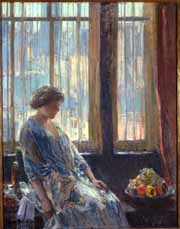 |
| The New York Window,
1912 Oil on canvas 46-1/8 x 35-1/4 in. (117.2 x 89.5 cm) The Corcoran Gallery of Art, Washington, D.C. |
CHILDE HASSAM: American Impressionist—
[Closing September 12, 2004]
Hilton Kramer—reviewing this show for The Observer—has suggested that Childe Hassam, even though he studied in Paris, was more of a traditionalist than he was a real Impressionist. In fact, a number of his early canvases have the musty look of the Academy about them, especially in subject-matter.
Hassam's triumph, however, was his vision of Fifth Avenue festooned with American Flags. It was so popular, he painted versions a number of times. That's why you may have seen Hassam's iconic patriotism in more than one museum collection.
In fact, Hassam painted a lot of pictures. So many the Metropolitan couldn't possibly show them all. When I saw a vintage Hassam in Henry Clay Frick's home, Clayton, in Pittsburgh, I wondered at first why it hadn't been loaned for the show. On closer examination, I could see that it was not very good. But Helen Clay Frick must have liked it…
In any case, Hassam was not one of your Starving Artists. He was immensely popular in his time and sold many, many paintings. The question is why the Met felt compelled to show so many of them in so much valuable gallery-space.
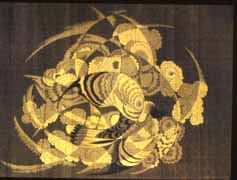 |
| 6. Michel Dubost
(French, 1879-1952) La Maison Ducharne, Manufacturer L'Oiseau dans la Lumière (Bird in the Light), ca. 1925 Metallic thread, silk 66 3/4 x 49 1/8 inches (169.5 x 124.8 cm) The Metropolitan Museum of Art Gift of Monsieur et Madame Jean Ducharne, 2004 2004.84 |
[Closing September 5, 2004]
The timing of the San Francisco Art Deco show and this handsome exposition at the Met Museum suggests a bi-coastal collusion. But there is no conspiracy afoot to foist once again Modernisme, Moderne, or Deco on an unsuspecting Public, East or West.
The truth is that there is nothing more Modern than Streamlined. And Parisian Art Deco's hallmark luxury and elegance—while not partaking of the Industrial Sleekness of the Chrysler Building—is still the essence of sophisticated Modernity.
The brilliantly achieved furniture designs of ebeniste Émile-Jacques Ruhlmann are the centerpieces of this intriguing exhibition. But with the Met's complementary Art Deco Paris show, it is enhanced—and placed in a temporal and fashion-context—with stunning costumes by Jeanne Lanvin, glass objects by René Lalique, and silver by Puiforcat.
Most of the 225 works on view in the main exhibition are drawn from the Met's own collections. Some hundred are specifically important Ruhlmann designs, not only furniture, but also hangings, lamps, and other complementary decor.
As most aficionados of Art Deco know, it takes its name from that famous 1925 Paris exhibition focusing on the Modern in domestic and industrial design. Unlike American Deco designers—many of whom wanted to bring sleek streamlining into the marketplace, with mass-manufactured applicances and artifacts—Ruhlmann and his colleagues were not designing for Everyman. These were—and remain—luxury art-objects, generally made by hand by skilled crartsmen, for a very discriminating and wealthy clientele.
A number of the pieces in both these shows are like Old Friends, for I photographed them long ago for The Art Deco News. And, whenever I see a glass panel, vase, or bowl by René Lalique, I recall having found & photographed the Lalique Vault in Paris's Père Lachaise Cemetery. Its centerpiece is a lovely piece of Lalique Glass! [Loney]
Copyright © Glenn Loney 2004. No re-publication or broadcast use without proper credit of authorship. Suggested credit line: "Glenn Loney, Curator's Choice." Reproduction rights please contact: jslaff@nymuseums.com.